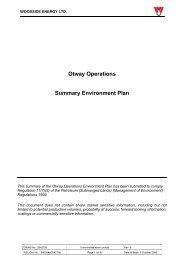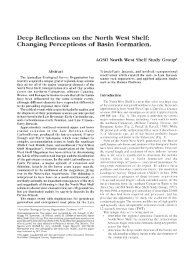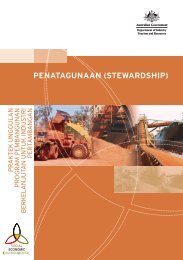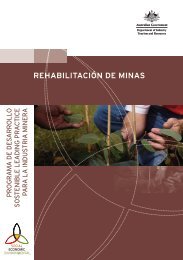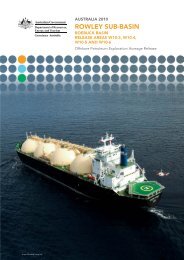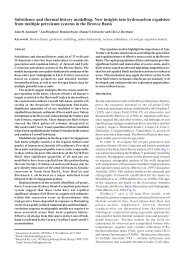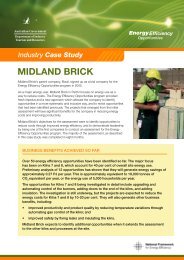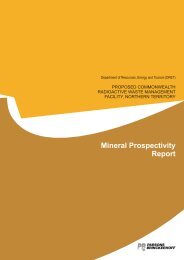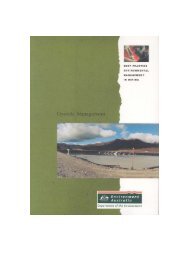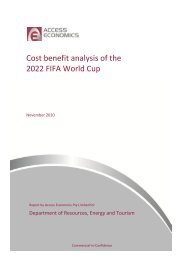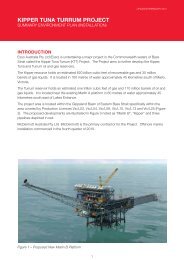A guide to leading practice sustainable development in mining
A guide to leading practice sustainable development in mining
A guide to leading practice sustainable development in mining
You also want an ePaper? Increase the reach of your titles
YUMPU automatically turns print PDFs into web optimized ePapers that Google loves.
Topsoil treatments<br />
For soils likely <strong>to</strong> be dispersive or acid generat<strong>in</strong>g, the use of amendments such as<br />
gypsum or lime will be required. In some cases it may be necessary <strong>to</strong> <strong>in</strong>oculate with<br />
symbiotic micro-organisms such as nitrogen-fixers and mycorrhizae. Ripp<strong>in</strong>g along<br />
con<strong>to</strong>ur will usually be required <strong>to</strong> facilitate root penetration through compacted<br />
spoil material and <strong>to</strong> reduce seed loss.<br />
Fertilis<strong>in</strong>g will also be required <strong>in</strong> most cases <strong>to</strong> replace the nutrient bank lost<br />
dur<strong>in</strong>g vegetation removal and the m<strong>in</strong><strong>in</strong>g process. It is essential that the types and<br />
methods of application of macro-nutrients and micro-nutrients are carefully planned,<br />
based on detailed soil characterisation studies and rehabilitation objectives and<br />
targets. Inorganic fertilisers are most commonly used; however, organic fertilisers<br />
such as sewage sludge or vegetation mulch can be a cost-effective alternative<br />
provided care is taken not <strong>to</strong> <strong>in</strong>troduce weeds and high concentrations of metals.<br />
Where <strong>to</strong>psoil conta<strong>in</strong>s a viable native seed source, it should be conserved for reuse<br />
follow<strong>in</strong>g m<strong>in</strong><strong>in</strong>g. This not only provides a cheap source of plants, but helps ensure<br />
that they establish <strong>in</strong> relative abundances that reflect pre-m<strong>in</strong><strong>in</strong>g densities, and<br />
promotes establishment of species whose seed may be hard <strong>to</strong> obta<strong>in</strong> or difficult<br />
<strong>to</strong> germ<strong>in</strong>ate. The bauxite m<strong>in</strong>e rehabilitation program conducted by Alcoa World<br />
Alum<strong>in</strong>a Australia <strong>in</strong> the jarrah forest of south-western Australia is an excellent<br />
example of how conservation of the soil seed bank can significantly enhance the<br />
botanical diversity of the post-m<strong>in</strong><strong>in</strong>g vegetation community. After vegetation is<br />
cleared, the <strong>to</strong>p 150 millimetres of soil, which conta<strong>in</strong>s most of the soil seed bank<br />
and nutrients, is stripped prior <strong>to</strong> m<strong>in</strong><strong>in</strong>g and then directly returned <strong>to</strong> a pit about<br />
<strong>to</strong> be rehabilitated, wherever possible. Research has shown that the majority of<br />
native plant species (72 per cent) on rehabilitated areas comes from seed s<strong>to</strong>red <strong>in</strong><br />
<strong>to</strong>psoil. The importance of directly return<strong>in</strong>g fresh <strong>to</strong>psoil has been demonstrated by<br />
trials compar<strong>in</strong>g this technique with s<strong>to</strong>ckpil<strong>in</strong>g. These have shown that disturbance<br />
associated with direct return of <strong>to</strong>psoil results <strong>in</strong> loss of less than 50 per cent of the<br />
seed conta<strong>in</strong>ed <strong>in</strong> the pre-m<strong>in</strong><strong>in</strong>g forest seed s<strong>to</strong>re; by contrast, s<strong>to</strong>ckpil<strong>in</strong>g results <strong>in</strong><br />
losses of 80 per cent <strong>to</strong> 90 per cent. Other aspects, such as the depth of respread<strong>in</strong>g<br />
<strong>to</strong>psoil, the season when the soil is handled and the tim<strong>in</strong>g of seed<strong>in</strong>g, are also<br />
important. Seed will not survive if buried <strong>to</strong>o deep, and persists better when the soil<br />
is moved dur<strong>in</strong>g the dry season. Also, plant establishment from seed<strong>in</strong>g is greater<br />
when the seed is applied <strong>to</strong> a freshly disturbed surface. Together, the comb<strong>in</strong>ed<br />
use of fresh <strong>to</strong>psoil return, seed<strong>in</strong>g, and plant<strong>in</strong>g of ‘recalcitrant’ plants have now<br />
resulted <strong>in</strong> numbers of plant species at 15 months-of-age equal <strong>to</strong> those recorded <strong>in</strong><br />
equivalent-sized plots <strong>in</strong> unm<strong>in</strong>ed forest (see LP Rehabilitation p.40).<br />
166 LEADING PRACTICE SUSTAINABLE DEVELOPMENT PROGRAM FOR THE MINING INDUSTRY






